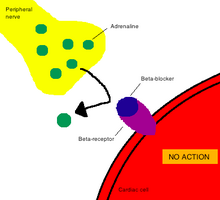
Back آلية عمل (صيدلة) Arabic Mecanismo de acción Spanish مکانیسم اثر Persian Գործելու Մեքանիզմ HYW Mekanisme aksi ID 作用機序 Japanese 작용 메커니즘 Korean Mecanismo de ação Portuguese Механизм действия Russian Mehanizam akcije Serbo-Croatian

In pharmacology, the term mechanism of action (MOA) refers to the specific biochemical interaction through which a drug substance produces its pharmacological effect.[2] A mechanism of action usually includes mention of the specific molecular targets to which the drug binds, such as an enzyme or receptor.[3] Receptor sites have specific affinities for drugs based on the chemical structure of the drug, as well as the specific action that occurs there.
Drugs that do not bind to receptors produce their corresponding therapeutic effect by simply interacting with chemical or physical properties in the body. Common examples of drugs that work in this way are antacids and laxatives.[2]
In contrast, a mode of action (MoA) describes functional or anatomical changes, at the cellular level, resulting from the exposure of a living organism to a substance.
- ^ Ogrodowczyk, M.; Dettlaff, K.; Jelinska, A. (2016). "Beta-blockers: Current state of knowledge and perspectives". Mini Reviews in Medicinal Chemistry. 16 (1): 40–54. doi:10.2174/1389557515666151016125948. PMID 26471965.
- ^ a b Spratto, G.R.; Woods, A.L. (2010). Delmar Nurse's Drug Handbook. Cengage Learning. ISBN 978-1-4390-5616-5.
- ^ Grant, R.L.; Combs, A.B.; Acosta, D. (2010) "Experimental Models for the Investigation of Toxicological Mechanisms". In McQueen, C.A. Comprehensive Toxicology (2nd ed.). Oxford: Elsevier. p. 204. ISBN 978-0-08-046884-6.
© MMXXIII Rich X Search. We shall prevail. All rights reserved. Rich X Search